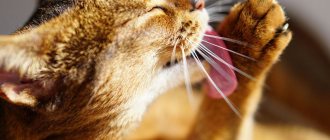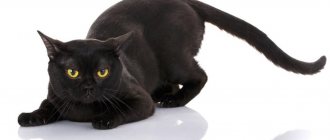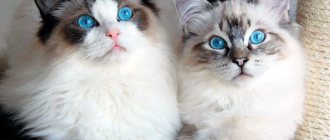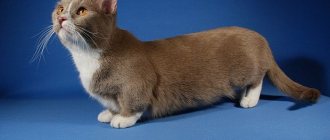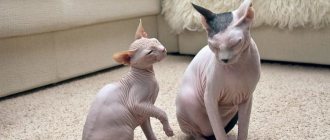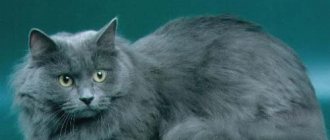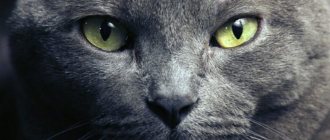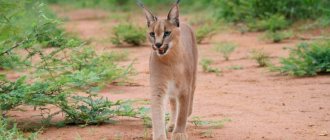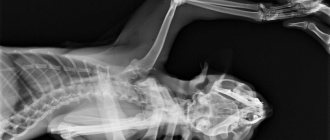What could be better than coming home where a devoted and faithful furry friend will be waiting for you. Getting a pet is not as simple a decision as it seems at first glance. You need to weigh the pros and cons, but if you decide, here are some tips for choosing a Bengal cat that may be useful to you.
The first thing you need to mentally prepare for is the price. You need to understand that these cats are purebred, as it is now fashionable to say, elite, and the price for them is appropriate. The cost of Bengal cats in Russia varies greatly, and can range from 15,000 to 120,000 rubles . We'll come back to prices later, but for now everything is in order.
Spotted color
The spotted color of the Bengal cat is the most popular color. If you have seen a Bengal cat, then most likely you have seen it in its spotted form. The brown spotted tabby color was recognized in Championship Status (TICA) in 1991.
Spotted Bengals have distinctive, small to medium-sized spots along the entire length of their body. Large, random, two-color rosettes are especially appreciated. This color in domestic cats looks like a mini-leopard. This style emerged when breeders believed that larger, sparser spots were more desirable. The original spotted tabby pattern found in domestic cats has been modified by selective breeding.
The coat is covered with random, diagonal or horizontally aligned spots on the body, belly and legs. Large dark spots on a light background are usually preferable.
Of course, there are variations in spotting, and one Bengal cat can have many different types of spots.
Single-Spotted
The spots are monochrome, one-color. These are simply solid spots splashed with droplets on a contrasting background, similar to wild cats such as Cheetahs or hybrid spotted cats (Ocicat, Egyptian Mau, Spotted Shorthair).
Bengals with solid spots are allowed to show, but are not preferred. Some breeders believe that they should not be allowed to compete.
The most popular spotted color for a Bengal cat is the Rosette Bengal. Spots are called rosettes when the spots are two-tone contrasting colors different from the background color. The Bengal cat is the only domestic cat with rosettes!
Rosettes in the Bengal breed began in the early 2000s, when some breeders bred the shade spots with darker spots. The rosette quickly developed.
When you see the evolution of the breed over the years, it is amazing to realize the progress that some rosette breeders have made in just a few decades.
The 3 most important types of socket:
— Arrows (Arrow-head) — Paw-print — Donut (Donut)
Arrowhead sockets
The arrows may be solid and monochrome in one spotted group, or they may be a variety of colors that fade toward the background. Well-defined arrow rosettes are rare and popular among Bengal cat owners and breeders.
The arrowhead socket is not the most common, but it is probably the easiest type of socket to identify. Arrow rosettes are shaped like a triangle, like the tip of an arrow or teardrop, with all ends pointing toward the back of the cat.
Asian leopard cats have many different color types, but the arrowhead pattern is one of the most visually impressive. Arrow-shaped spots are excellent camouflage in the dim light of a forest habitat. With such fur, a cat that stands motionless on trees or in fallen leaves is very difficult to notice.
The Bengal cat breed standard requires the spots to be horizontally aligned instead of the vertically aligned spots of the classic tabby. The arrow-shaped spots on the coat give them the appearance of illusory movement or motion blur.
Donut outlets
Donut rosettes are spots darker than the main background, outlined by an even darker outline.
The donut rosette gets its name from the almost complete dark outline around a lightly colored center.
It took years of selective breeding to create the donut-shaped rosettes, but they are now one of the most popular rosettes.
Paw-print rosettes
Paw print rosettes are shaded spots that are open on one side with smaller, darker spots on the edge. Such a rosette is never completely covered by a dark outline.
Footprint rosettes get their name because they often look like small paw prints running across a cat's body.
Smoked sockets
Smoke rosettes are large, full rosettes that seem to fit together like a puzzle with little space in between.
Chain socket
Chain rosettes are a linked series of donut rosettes connected horizontally and running parallel on either side of the cat's spine.
The chain rosette can also be seen on wild cats such as Ocelots.
Clusters of rosettes
Rosette clusters are small spots that form clusters around a central color.
What does the price depend on?
First of all, the main component of prices is the pedigree of the cat ; the more intense the color of the leopard, the higher the price. The age of the cat also plays an important role. Kittens are much more expensive than adults. This is due to the fact that it is easier to train a kitten and bring it closer to its way of life.
It is worth saying that the kitten is ready to move to a new place at the age of 3-4 months, not earlier. In order to avoid problems in the future, it is necessary to conclude a purchase and sale agreement between the seller and the breeder; along with the agreement, the buyer receives all relevant documents, including a pedigree (if any).
The price also largely depends on the class of the animal; the lower the class of compliance with all parameters, the lower the cost. The class is determined by several parameters, such as color, breeding stock, difficulty of care, health, and so on.
Marble color
The marbled pattern is formed from “liquid” spotted stripes swirling in a whirlwind. The ideal marbled Bengal cat has a horizontally flowing, random, asymmetrical structure consisting of swirls of two or more colors.
The marbled Bengal cat has four official types: reduced horizontal flow, horizontal flow, chaotic pattern and leaf marble patterns.
In 1987, Gene Mill (Millwood Cattery) released the first marbled Bengal kitten, a cat named Millwood Painted Desert:
She was an impressive little female with a strange, soft, creamy color and a strange pattern that looked like an ice cream caramel. At the Incats show at Madison Square Garden, and all over the country, she was a sensation!
In his first standard for the Bengal breed, Jean Mill did not intend to include anything other than spots. But Painted Desert was an instant success with both the judges and the public, and so the marble was included in the Bengal breed registry.
Descendants from these early marbled Bengals contributed to the description of the gene and horizontal flow that produced the first "rosette" spots in the 2000s.
In 1993, the merle color of the Bengal breed was included in championship status within the TICA.
Bengal character
The character of Bengal cats combines the emotionality of a wild animal and the friendliness of a domestic pet. In turn, Bengals have a pronounced hunting instinct, and therefore they are impressed by dynamic games. For example, they like to have fun with a bow, roll a ball, and keep an eye on their prey. They are easily able to catch mice, although they rarely eat such a catch.
If you raise a Bengal correctly, you will certainly grow up to be a sociable, affectionate and inquisitive cat. The latter can get along well with other animals, except rodents and birds, and adores children. By the way, Bengals are quick-witted and amenable to training. The Bengal cat loves water, and therefore there will be no problems with bathing the animal.
Bonus: Marble Spot or Sparbl
)
Do you think that spotted and marbling patterns have never been seen before?
Look at the coloring where the spots and marbling merge. "Sparbling" is not actually an official color, but is used in the breeder's dictionary to describe Bengals that have both rosette and merle markings.
Sparble is considered a spotted Bengal cat, not a marbled cat.
Now that we have looked at the different patterns that Bengal cats have, let's look at the colors of the Bengal cat.
Like other cat breeds, Bengals come in a variety of colors. There are about 6 colors of the Bengal cat, divided into standard and non-standard by the International Cat Association (TICA).
Standard Bengal colors:
— brown (gold) — snowy — silver
Unrecognized colors:
— coal (charcoal) — blue — melanistic (black)
Yes, these are standard cat colors. But, of course, the complex beauty of the Bengal cat is not only 6 color options. No. The Bengal breed has many more colors and shades. But, regardless of color, the pattern on a Bengal cat should provide a high degree of contrast.
Types of sockets
Rosettes can vary both in size: from very small (“polka dots”) to quite large – and in shape. Below are the three most important types identified by specialists in breeding the Bengal breed.
Arrowhead sockets
This is not the most common rosette shape, but it is the easiest to identify. The shape of such spots can be called conventionally triangular, since it resembles an arrowhead or a drop. The arrow-shaped spots on the coat create the illusion of movement or blur in movement, which has given the Bengal a reputation as a special, “mystical” breed. The Bengal breed standard requires that the spots be located exclusively horizontally; this distinguishes this type of color from the classic tabby, where the pattern follows the “ribs” of the cat.
Paw-print rosettes
A spot similar to an animal paw print: the circumference of the rosette is clearly defined, with dark spots present along the contour of the circle in the form of small strokes. The circuit of such a socket never forms a ring, that is, it does not completely close.
Donut outlets
The prototype and inspiration for this color feature in Bengals is the jaguar, and the spots on the cats’ fur actually resemble donuts. The donut rosette is formed by darker shades along the contour (and there should be at least two such shades), as well as a light center. This rosette is one of the most common forms.
Some other types of sockets should also be described.
Smoked sockets (Clouded)
Large, full, they visually resemble a puzzle piece with a small gap between the spots. The edges of the rosettes should be sharp and clear, and the contrast between them and the main tone of the coat should be as pronounced as possible. The ideal pattern of this kind of rosettes can be observed in nature: the clouded leopard (Neofelis nebulosa) is distinguished by it.
Chain sockets
A chain of interconnected donut rosettes that are connected horizontally and run parallel on either side of the cat's spine. The outline of such outlets should be very clear and bright; each of them must contain at least two different shades. They should stand out sharply against a very light and necessarily uniform tone of the main background of the coat. An example of a chain rosette in the wild is the coloration of ocelots.
Cluster sockets
Clusters are clusters, that is, collections of rosettes, or small spots, grouped around a center, which is always distinguished by a lighter shade. Cluster rosettes may not have a clear closed circle, but rather a cluster of small, shallow rosettes around a light center. The main difference between a cluster pattern and the paw print rosette variant is that the cluster dots surround a light spot in the shape of a cluster, while in a paw print pattern the pattern points are offset to one side, leaving the other side open. In nature, an example of a cluster rosette is the pattern of leopard fur.
Merged sockets
Marble color
The marbled pattern of Bengals consists of various horizontal swirling stripes and a kind of “island” on the coat. The drawing must be positioned exclusively horizontally and have a smooth appearance. In addition, it should be asymmetrical and create a feeling of randomness.
The merle color consists of curls and forms a pattern that cannot be found in any other breed. The main color of the coat should be pure; the contrast with the base color should be as strong as possible, with clear markings with clear edges. The marking is two-color, having a horizontal or diagonal direction. Symmetry of the side pattern is not required. There should be no resemblance to the classic tabby pattern, and a circular or bullseye pattern is not desirable. The more random the pattern looks, the better. Additional color tones within the design are desirable, giving a “stained glass” effect. Patterned markings on the shoulders and colorful markings on the legs and tail are desirable. Rosettes and spots may be present, especially on the legs. The color of the chest and belly should be lighter than the main color, and the pattern should also be located on the belly. Circular or vertical marks are considered defects. It is especially highly valued when the marbled color of the Bengal is formed by three colors: the background shade, the pattern itself and its edging. (3)
This type of color develops slowly: the process is completed only when the cat is two years old.
Color Sparble
The Sparble color is a combination of spotted and marbled patterns. The body color is light and monochromatic. The pattern is a darker shade, horizontal, and combines a marbling pattern that is fused with spots of varying sizes throughout the body and limbs.
Brown (golden) Bengal cat
The brown (or golden) Bengal (C,C color genes) is the most popular of the Bengal cats, and was the first cat to be recognized by TICA in 1983.
Traditional brown Bengals have green or gold eyes.
The background color can vary from a gray-brown tone to a bright orange-gold.
The color of the spots, rosettes, or marbles can range from black/light brown to darker or reddish brown.
If you have a brown furry friend, you probably know that brown comes in a variety of shades such as: gold, cream, dance, honey, taupe, dance, beige, caramel, cinnamon.
All shades of brown are acceptable, but orange-brown is preferred for the main background color of the coat.
As you can see, almost all shades of brown are available for the Bengal breed.
Now, if you look at a brown (golden) Bengal, you will notice the following characteristics:
- Brown tail with a black tip - Pink nose - Brown, copper, gold, green or brown eyes - White belly preferred
Magnificent creatures, aren't they?
Pros and cons of the breed
To make a final conclusion about the breed, it is worth looking at their key pros and cons.
Pros of Bengal cats:
- the animal is very independent;
- very clean and well-mannered;
- quickly understand what the owner requires of them;
- have beautiful, almost precious fur;
- they never get bored or sad, they manage to cheer up even their owners;
- easy birth without complications.
Cons of Bengal cats:
- problems with the gastrointestinal tract;
- high price;
- wayward character;
- constant need for communication;
- even an adult remains playful and very active.
Despite all the pros and cons of the breed, reviews from owners often say that the Bengal is suitable for any loving owner.
Snow Bengal cat
Looking for Mini Bars? Then this is the cat you are looking for.
Unlike the name, they are not completely white Bengal cats.
In fact, the Snow Bengal color comes in 3 genetically different colors (and names):
— Snowy Sepia — Snowy Lynx — Snowy Mink
It can be difficult to tell the difference between these three colors. A genetic test is always the best method for differentiating the 3 snow bengals. Alternatively, eye color can help determine the Bengal's snow color.
Snow Lynx (color genes Cs, Cs) has:
- Very light white cream color - Dark or light markings - Dark tail tip - Blue eyes. Always.
Snow Mink (color genes Cb, Cs) has:
- Ivory, cream, light-tan - Various shades of markings from light beige to dark beige or coffee - Dark tail tip - Blue-green or aquamarine eyes
Snow Sepia (color genes Cb, Cb) has:
- Ivory, cream, light-tan - Various shades of markings from light coffee to dark - Dark tail tip - Green or gold eyes
Not so bad, right? Isn't it too difficult now to determine which Bengal color you want?
Characteristics and habits
Thanks to active efforts and strict selection, the Bengal cat has a good character. Breeders managed to breed active, affectionate and intelligent cats. The work is still ongoing, but the breed has already developed its own behavioral characteristics.
It is not so important how much a cat costs and what kind of jewel it represents in the animal world. It is much more important whether her character is compatible with the character of her owners.
Attitude towards people, children, animals
Despite its wild nature, the Bengal cat breed loves company. They cannot be alone for a long time. Cats have a hard time making contact with strangers. They get used to the owner who supports them and trust only him.
They treat children with patience; they try to avoid babies. If a child strongly pulls the Bengal's tail, whiskers, or ears, he may respond. It is better to explain to children in advance how to behave with a pet. They love to play with children aged 9-13 years, which thoroughly exhausts each other, and then they sleep soundly. They live well in the family.
Important!
Bengals always choose one person (the main one) to spend more time with. The other owner is perceived as a victim and may bite and scratch him in a playful manner.
Cats do not get along with other pets because... begin to divide the territory. At best, each will choose their own corner without disturbing the other.
Education, obedience, training
The wild Bengal cat carries 25-70% of the blood of a wild animal. It is impossible to make an obedient domestic kitty out of her. An animal can live with a person only on its own terms. Despite the fact that upbringing and Bengals are not very compatible, they themselves are quite aristocratic and well-mannered.
Breeders accustom kittens to being handled from the first day of birth. Otherwise, the person will become an enemy for the Bengal cat. At all stages of growing up, the owner actively interacts with the animal with his hands.
The Bengal cat receives positive reviews when it comes to training. Cats are successfully taught basic commands and even complex tricks. By watching people, they independently learn to open taps, doors, cabinets, and press switches.
Playfulness, curiosity, activity
Bengals love to run, jump, skip and climb. It is better to install a full-fledged play complex for them, where they can play, relax, and hide.
They constantly carry their toys in their teeth and even bring a ball to their owner. In this they are similar to dogs. Plays with ribbons and feathers with great interest. Needs a lot of toys. They love to take part in new games.
The Bengal cat breed is not afraid of water, because... their wild ancestor regularly walked in the rain and crossed rivers. They can easily jump into the bath and play with the tap water.
Important!
Not everyone understands why a Bengal needs a playroom. If your Bengal does not play regularly, he will begin to toil and release excess energy in destructive ways.
Intelligence
The main features of Bengal cats are their developed intelligence, willfulness and quick wit. If a Bengal sees a person opening the door where he hides his treats and toys, he will independently get what he needs. Then you shouldn’t be surprised why the cat treacherously takes out all the owner’s supplies.
Animals are always coming up with something. They can play with ordinary household things and have fun. They easily find new loopholes, minks, and conquer heights. They engage themselves independently.
Many reviews tell funny stories about how the animal independently opened the closet and carefully pulled out things from there. The intelligence in the eyes of an animal is easy to see even on video.
Sensitivity
The Bengal domestic cat has a reverent character. They cannot tolerate shouting or inappropriate treatment. Avoids conflicts in every possible way. If a pet is offended, it will leave and hide. He will wait until the owner and himself calm down.
They feel guilty. If the pet has done something wrong, it will suck up to its owner and meow pitifully.
Instincts
The cat has a good hunting instinct. She is freedom-loving, will not be able to tolerate long hugs, and will not sit in one place for hours.
Does not like enclosures or closed small rooms. She needs free space around. Otherwise, she will scratch the doors, become indignant, and become fearful and aggressive.
Important!
A Bengal cat cannot be forced to do anything. It is important to give her freedom and respect her personal space.
Silver Bengal cat
Silver (I,I inhibitory genes) is more of a color deficiency. This gene blocks any warm colors and produces an almost white background that contrasts with the bright dark markings. Silver color was added to the TICA Championship in 2004 for the Bengal breed.
Silver Bengal cats come in a variety of shades with backgrounds ranging from white to a very dark, steely color.
Silver can also be found in any other color combination: Snow Silver, Charcoal on Silver, Blue Silver, etc.
Silver Bengal has:
- As little yellow and brown as possible in color - Dark gray to black markings - Black tip of tail - Brick red nose - Green or gold eyes
It should be easy to tell which cats are silver!
Classification Features
The classic color of the Bengal breed is a golden tone of the undercoat with bright rounded spots of various black-brown shades in their most varied variations, from milk chocolate to black. The belly, bleached almost to a platinum hue, is welcome, and this is also a reference to the original origin of Bengals from wild ancestors.
All Bengals are genetically black or blue in color (the bleached black gene in cats), but the shape of the pattern on their coat is extremely varied and varies from spots that look like “polka dots” to fancy round “lambs” and vague “islands” throughout the body of the cat. The pattern can be spotted or marbled; it is important that all elongated fragments are oriented horizontally; tendencies towards the formation of vertical stripes are unacceptable. The spots can have any size and shape, including something as exotic as, for example, “oyster shell” or “butterfly wings.” Complex stains are preferable to simple single ones. It is necessary that each drawing clearly contrasts with the background, is impeccably clear, with clearly, even sharply expressed outlines. There is no special standard for the pattern of spots, there is only a single requirement: the main background of the coat must be extremely clean and uniform, and the pattern must be equally extremely clear. The introduction of such a standard would be pointless, since absolutely every Bengal has its own “own” unique color. Repeating patterns do not exist in nature, clearly demonstrating the boundlessness of her imagination. It is not without reason that all these spots, rosettes, etc. are often compared to human fingerprints - they are just as unique.
A distinctive feature of the Bengal breed is considered not only its amazing color, but also the quality of the fur of these animals. In the short-haired variation of the breed, it is thick and dense; unusually soft and silky to the touch, it creates an indescribable sensation when you touch it. (2)
Types of colors:
- spotted Can be expressed in the form of single spots (single spotted) and rosettes (rosetted);
- marble;
- sparble (sparble from the English marble + spotted, that is, spotted + marble).
Charcoal (Charcoal) Bengal cat
The Charcoal Bengal (Ab, a or Apb, Apb color genes) is darker than the traditional recognized Bengal colors. The black, smoky charcoal color was especially noticeable in the early generations of F1 and F2 Bengals.
The Charkoal trait is inherited regardless of color, and can be exhibited in every color class: brown, silver, snow (Lynx Charkoal, Mink Charkoal, Sepia Charkoal) and even blue.
Charcoal Bengals have a dark gray or charcoal background with some (not red) and very dark spotted or marbling patterns.
The Charkoal may also have a darker face mask and a thick stripe, commonly referred to as the "Zorro mask". The mask resembles an inverted letter "Y".
The Charcoal Bengal's mask can be very dark, eventually matching the color of the black body markings.
The tail is dark brown/black or grayish-black with stripes and a black tip.
Common colors
The color standard for Bengals is strict. A newborn kitten receives an alphanumeric mark indicating the color and type of fur pattern.
The breed designation according to the international classification is BEN.
The color basis of Bengal colors is indicated in Latin letters:
- n – black;
- ns – silver;
- ny – gold.
At the end of the color designation, put the figure number:
- 22 – marble;
- 24 – spots and rosette;
- 31 – snowy sepia;
- 32 – snow minx;
- 33 – snow links.
Separately, there are unrecognized colors that do not have a designation:
- blue;
- coal;
- melanistic.
To determine the color of Bengals by number, you should use the table.
| designation according to international classification | transcript |
| BEN ny 22 | marble gold |
| BEN ny 24 | spotted golden |
| BEN ns 22 | marble silver |
| BEN ns 24 | spotted silver |
| BEN n 31 | sepia |
| BEN n 32 | minx |
| BEN n 33 | links |
| BEN n 24 charcoar | carbonic |
| BEN n 24 melanistic | melanistic |
| BEN a 24 | blue |
Gold and silver colors are the main colors for Bengals. With a golden color, the iris is yellow or yellowish-green, the pads of the paws are brown.
Golden color implies many shades, Bengal can be:
- chocolate;
- ginger;
- chestnut;
- brick;
- beige;
- dark brown;
- light brown.
Silver cats have a cool bluish-gray coat. The pattern is black or rich gray. The undercoat is white or grayish-white, and the belly is similarly colored. The paws and tail are black, and the lobe is reddish-brown. Silver Bengals have yellow or green irises.
Important! Blue-eyed Bengal cats are considered defective and are not allowed for breeding.
Blue Bengal cat
Blue color (d, d dilute genes) is very rare, but some breeders are working hard to try to promote blue Bengals to championship status.
Blue Bengal cats are blue-gray in color with cream tones. Mottled or marbled pattern - dark blue or metallic gray.
Since this is a regenerative gene, both parents must be blue to produce a blue Bengal cat.
Blue Bengals also have:
- Steely blue background color - Blue markings that never turn black - Dark gray tail - Gold, green or brown eyes
Care and maintenance
The cat took from its ancestors not only beauty, but also independence. Caring for its appearance is very simple.
Moving into a new home
Keeping this breed is a little more difficult than keeping a regular cat. Bengals need an organized territory, where there will be a food, recreation area and, of course, a large play area. Then he will not spoil the furniture and disturb the owners.
Basic set of items:
- A full bowl of clean drinking water and dry food should be freely available.
- Place a tray in a secluded place that matches the size of the cat. Representatives of the breed like to actively bury their surprises, so the layer of filler should be large.
- It is advisable to install a running wheel where cats will expend excess energy.
- A scratching post is a must. Sometimes one set of cat posts is not enough. The animal is allowed to sharpen its claws only in one place, away from upholstered furniture and walls.
- You can equip a sleeping and rest area. If she is not there, the pet will find a place for itself in a chair, on the sofa or in the bed.
Hygiene and medical procedures
Caring for Bengals is simple, although it should still be done regularly:
- It is enough to brush your cat once a week. The fur is short. She does not need daily brushing, because... tangles do not form, and shedding is not as obvious as in long-haired breeds.
- Discharge from the eyes is removed daily using a damp cotton pad. Some animals cope with them on their own.
- Ears are examined every 1-2 weeks. They should be clean and light pink in color. If there is dirt, clean the ears with a damp cotton pad.
- To prevent your pet from tearing up the beautiful interior and upholstered furniture, her claws are trimmed every 2 weeks. Use a special nail clipper. Even if you have a scratching post in your home, you still need to trim its claws.
- It is not necessary to wash the libimitsa; they are very clean. Bathing is carried out no more than once every 3-4 months, or it is carried out with very intense pollution. They use only specialized products for cats. Bengals love water, so washing them will not be a problem.
Diet
The most convenient and simplest feeding option is to purchase ready-made commercial feed. The menu will be balanced, healthy, and the owner will not have to cook.
They buy premium, super-premium, holistic food. Like its wild ancestors, the Bengal cat has a shortened intestinal structure. She has a sensitive digestive system that immediately reacts to low-quality food, chemical additives, and changes in diet. Finding the right food will take some time.
Some owners still prefer natural food:
- 80% of the total diet is meat. It must be dietary. Suitable for turkey, chicken, rabbit, beef. 1-2 times a week you can treat your cat to low-fat varieties of fish. The fillet should be boneless. The meat is deep frozen in advance for at least 3 days. Before serving, it is doused with boiling water. This way the owner gets rid of parasites and bacteria.
- They are not allowed to give milk, but it is useful to treat them with fermented milk products. Kefir and low-fat cottage cheese are an excellent addition to the basic diet.
- Vegetables. To ensure that the cat receives all the necessary vitamins, raw or boiled vegetables are added to the meat.
- Cereals must be included in the daily diet. They are boiled in water in advance.
Important!
Food from the human table negatively affects the health of the pet. You cannot treat them with sweets, highly salty foods, or fatty fried meat. Beans and potatoes are contraindicated.
Black (Melanistic) Bengal cat
Black Bengals (a, a color genes) have black patterns on a black background that remind us of the melanistic color variant of leopards and jaguars: the black panther.
The background and pattern colors are the same in Bengal Melanistic. Their patterns are called "ghost markings" or "ghost spots" because they are barely noticeable. But you will still be able to see the pattern in daylight, just like on a black panther.
Black Bengals are rare and less popular among breeders as these color variations are frowned upon by associations.
As for the spots, they can be faint, dark brown to black, and can sometimes only be seen in natural sunlight.
The Smoky Bengal is a silver melanistic variation.
If you are looking for a black mini panther, this Bengal cat color will be your best choice!
Hereditary diseases
In addition to infections, any cat is susceptible to genetic diseases. This problem has not escaped the Bengals either. There are several types of most common diseases.
Gastrointestinal problems
This is a problem of the first order. Bengals have a sensitive stomach and a shortened intestinal structure, characteristic of wild cats. They are susceptible to food poisoning. It is difficult for animals to choose food; it is rarely possible to do it the first time. Any new treat causes digestive problems and changes in stool.
Here, owners will have to be patient and give preference to holistic or premium food. It is better to coordinate the new menu with the veterinarian, informing the doctor about the pet’s problems.
Progressive retinal atrophy
The disease is painless for the cat and unnoticed by the owner. Gradually the retina of the eye dies, leading to complete blindness. It's not always clear why this happens. Usually the disease is diagnosed at the age of 5-6 months. It can be stopped early to avoid big problems. Nothing can be done about the chronic form.
The first symptoms are night blindness, avoidance of dark rooms, slow movements, lack of reaction to a change of environment (crashes into a new table or jumps onto a cabinet that no longer exists).
Hypertrophic cardiomyopathy
Cardiovascular disease can be congenital or acquired. This is a tendency to heart disease, which is provoked by one of the thickened walls of the myocardium. In the early stages, the disease is not diagnosed during a standard examination; there are no symptoms. If left untreated, it can cause sudden death.
For this reason, it is important to conduct an annual cardiac ultrasound and ECG to ensure that your pet does not get worse. With medication support and a calm lifestyle, the cat will live a long life.
Important!
These diseases are rare. Despite this, it is important to monitor the animal’s condition in order to prevent the development of a chronic form of the disease.
Glitter (Shine)
Do you want a magic cat? Glitter is your golden ticket—literally.
Bengals are the first domestic cat to have glitter. But not all Bengals are glittery!
You may see the glitter in a shimmering, sparkling effect on your cat's fur. Even in low light you can see the sparkle of the glitter on the Bengal.
But what is this glitter, glitter?
“Glitter” is a translucent, hollow hair shaft that catches light and reflects it. It is present throughout your cat's fur.
It is truly a beautiful and wonderful sight. Who knew cats could be even more magical?
Domestic cat breeds
Of the most spotted and fluffy cat breeds, the tabby color is recognized as the only one in only three. It was obtained without the participation of wild cats.
Ocicat
Ocicats are the result of crossing 3 types of cats: American Shorthair, Abyssinians and Siamese. In their behavior, these cats strongly resemble nimble dogs. They become very attached to their owner, love road trips and are constantly on the move.
Due to its playful nature, the Ocicat should have as many toys as possible. Otherwise, he will definitely borrow your things.
It would also be a good idea to buy a play set that will allow your pet to stretch its legs and frolic to its heart's content. Thanks to its love for outdoor games, the Ocicat can be taught several tricks: overcoming barriers and jumping through a hoop on command.
Egyptian Mau
The graceful Egyptian Mau is easily recognized by its “scarab” - a black mark on its forehead in the shape of the letter W. This cat is endowed with an inexhaustible supply of energy and curiosity. She is especially delighted by clockwork mice and various hiding places such as a linen closet and cardboard boxes.
Curious:
The maximum speed of the Egyptian Mau is the same as that of the leopard, that is, 58 km/h.
To get rid of yellowness before the exhibition, the Egyptian Mau with a silver color must be washed with a special tonic. There are usually no problems with bathing, as these mustachioed pets love water. Until they dry completely, they should be protected from drafts, which can cause the development of a cold.
Pixiebob
The pixie-bob's ears are decorated with lynx tassels, and on their back side there are light spots. The main feature of this cat is its low-set, short tail. Its size is about 5 cm.
Like the Egyptian Mau, pixiebobs love water. Despite this, you should not abuse the frequency of bathing. This can thin the coat and lead to dry skin.
Pixiebobs have a patient and delicate nature. They are equally affectionate towards adults and children and are only wary towards strangers.
Bengal colors
The Bengal cat breed offers a range of incredible colors and patterns similar to those found in the wild.
Let's list them all with this infographic illustrating all the colors and patterns of the Bengal cat:
You can find the cheetah in the brown spotted color, the leopard and jaguar in the brown color, the snow leopard in the silver or snow color, and the black panther in the melanistic color.
Almost all big cats have miniatures represented in this magnificent cat breed.
There are two types of Bengal cats: spotted and marbled.
The spots may appear as rosettes or dots.
Marble patterns appear as elongated, spotted stripes and are a rarer pattern among Bengals.
When it comes to Bengal cat colors, just like your typical cat, they come in a wide variety.
You have browns and oranges, you have creams and whites, silvers, blacks, blues and charcoal.
There are many bengal cat hybrids out there and you can't help but love them all!
Author
Rudakova Anna
- Vice-President of the World Cat Federation (WCF), expert on all breeds, breeder of Oriental Shorthair, Siamese and Bengal breeds. Experience since 1997.
The Bengal cat breed is one of the most popular in the world. It ranks third after the British Shorthair and Maine Coon. (1)
Bengals are medium to large sized cats known for their richly colored, contrasting coats with bright spots or distinctive marbled patterns. Actually, this is the main distinguishing feature of the breed, for which such cats are most often chosen - as, incidentally, also for their curiosity and loving character. This breed was originally developed by crossing domestic cats and the Asian leopard cat, which is why the Bengal is the only domestic cat that can have rosettes similar to the markings on the skin of the leopard, jaguar and ocelot. Today, the domestic Bengal cat comes only from crossing Bengals with other Bengals.
Bengals tend to be confident, curious, and loyal companions. They get along well not only with other cats, but also with pets in general - it is only important to correctly “introduce” the pets to each other. Bengals love being part of a family. (2)
Each representative of the Bengal breed carries the genes of their ancestors - leopards, therefore Bengals are distinguished by a special head structure (the so-called wild type) and plasticity and grace characteristic exclusively of wild cats. But the main thing is their fantastically beautiful color, for which they are appreciated by numerous fans of the breed. This is beauty given to the Bengal by nature and carefully preserved by the breeders of the breed.
This is a fairly young breed: a little more than half a century has passed since its appearance, but even during this short time the breeders managed to consolidate the phenotype and color.
